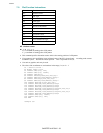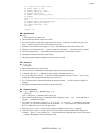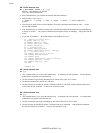10/10/03
CHAPTER 4 HP-GL/2 - 37
170 'Source 2
180 LPRINT "FT10,50;PA4000,5000;RR500,500;PA4500,5500;RR500,500;"
190 LPRINT "FT10,1;PA4500,5000;RR500,500;PA4000,5500;RR500,500;FT;"
200 '
210 '( POLYGON )
220 LPRINT "PA2000,1000;PM0;PDPA4000,1000,3000,3000;PM1;"
230 LPRINT "PA2500,1200,3500,1200,3000,2500;PM1;"
240 LPRINT "PA3000,800,3700,2500,2300,2500;PM1;"
250 LPRINT "PM2;FP;"
260 LPRINT CHR$(27); "%0A";
270 LPRINT CHR$(27); "E";
280 END
<Sample 45>
UL - User-defined line type
UL [ i ] [,g [...,]] [;]
i ; unit type g : gap length
• This command allows you to define line types which you can then subsequently select with the LT
command.
• i must be in the range 1-8. i identifies the line type that is to be defined.
• The index parameter uses absolute values.
• g (the gap length) alternately specifies pen up and pen down parts of the defined line type. A maximum of
twenty line sections are permitted, the first of which is a pen down section. Numbers must be integers in
the range 0~32767. These numbers are converted to percentages by the LT command.
• Maximum definition for the gap of each line type is 20.
• The sum of the gap parameters must be greater than 0.
• Specifying an index number with no gap parameters sets the line type to the default pattern for that index
number.
• Using the command with no parameter sets all line types to the defaults.
10 '-User Defined Line Type-
20 WIDTH "LPT1:", 255
30 LPRINT CHR$(27); "E";
40 LPRINT CHR$(27); "%0B";
50 LPRINT "IN;SP1;;"
60 LPRINT "UL8,0,15,0,15,0,15,40,15;"
70 LPRINT "LT8,5;PA2000,2500;PDPA5000,2500;PU;"
80 LPRINT "UL4,40,15,0,15,0,15,40,15,0,15;"
90 LPRINT "LT4,10;PA2000,3000;PDPA5000,3000;PU;"
100 LPRINT "UL1,40,40,40,40,40;"
110 LPRINT "LT1,10;PA2000,3500;PDPA5000,3500;PU;"
120 LPRINT CHR$(27); "%0A";
130 LPRINT CHR$(27); "E";
140 END
<Sample 46>
WU - Select unit for pen width
WU [ t ] [;]
t ; unit type
• This command specifies the pen width unit. It applies to all pens.
• t must be either 0 or 1.
• If t is 0 the pen width parameter which accompanies subsequent PW commands will be treated as a reading
in millimeters.
•
If t is 1 the pen width parameter which accompanies subsequent PW commands will be treated as percentage
of the distance between the scaling points P1 and P2. The default width is 0.1% of the diagonal distance
from P1 to P2.


















